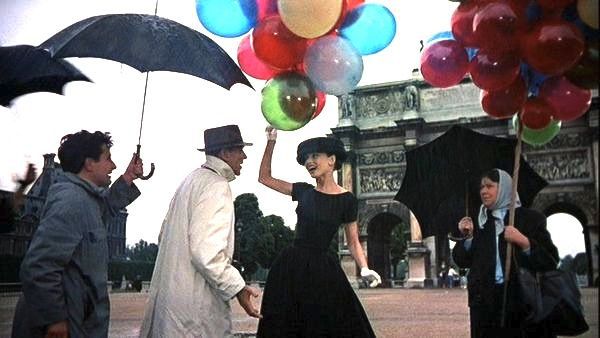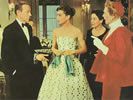Eye For Film >> Movies >> Funny Face (1957) Film Review
Funny Face
Reviewed by: Anne-Katrin Titze

Funny Face's opening credits, designed with fashion stills by Richard Avedon, immediately introduce us into a world suspended between reality and dream. For Stanley Donen, there is no conflict between the two and it is magic for us. In On The Town and Singin' In The Rain, both co-directed by Donen with Gene Kelly, painted picture book backgrounds, studio sets or actual city streets are linked fluidly with movement and colour. New York, Hollywood, now Paris, get the Donen touch.
Avedon provided the photographs and inspiration for the character of fashion photographer Dick Avery, played with incomparable charm and grace by Fred Astaire. Then Harper's Bazaar editor Diana Vreeland, found her way, uncredited and unacknowledged by herself, into the picture in the shape of Kay Thompson’s character, Maggie Prescott, the uncompromising editor-in-chief of Quality magazine in New York.

The multi-talented Thompson, who is also the author of the Eloise children's books and, like her feisty heroine, used to live at the Plaza Hotel, sparks the show with her Think Pink opening number, telling the women of America, no, make that the women everywhere, that "red is dead, blue is through, green's obscene and brown's taboo." Thompson, who is Liza Minnelli’s godmother and mostly worked behind the scenes at M-G-M as vocal coach and music arranger, gives her portrayal military strength and her coordinated army of assistants at the magazine are a devoted chorus.
Prescott and Avery are looking for a new way to sell "clothes for the woman not interested in clothes." They hit the streets, model (Dovima as Marion) and staff in tow, looking for a location, and stumble upon Embryo Concepts. In a take-over of the Greenwich Village bookstore for their photo shoot, they conspire to ignore the protests of sales clerk Jo Stockton (Audrey Hepburn). Through fast-talking, fast-action, Avery positions her into the background as "atmosphere" before even Prescott and her minions know what is going on. When Jo continues to express her disapproval for what they represent while being photographed, she is locked out.
Empathy and sincerity come into question - Avery stays behind to help Jo clean up the mess the magazine crew left and even a shapeless sack smock and dowdy haircut cannot hide her allure. Convinced she's the one, he gets permission from Prescott to use the magazine's darkroom to develop the photographs he took of her.
Jo soon is to be lured up to the offices with the excuse of a book order commanded to be placed by Prescott. Unimpressed by the fashion world and their devotion to the "perfect mouth" or brow, she runs off, ending up in the darkroom to escape the enormous scissors that want to start her transformation into a swan right there and then.
The plan, unbeknownst to Jo is to fly her to Paris for a location shoot of the brand new exclusive collection by couturier Paul Duval (Robert Flemyng). Hubert de Givenchy designed the magnificent clothes.
The title song Funny Face takes place in the darkroom, where Avery is developing the photographs. "In desperation one doesn't examine one's avenues of escape," she says on how she ended up there. He knows that Jo will be perfect to personify the new attempt at the intellectual look the magazine has been searching for. Since he found out earlier that she actually wants to go to Paris to meet her idol, the famous founder of "empathicalism", professor Emile Flostre (Michel Auclair), the convincing he thinks should be easy.
"Bonjour Paris!" - Jo is joyous to have found Montmartre and Montparnasse as she imagined and bonds, through empathy by buying drinks for the locals who frequent the cafés and bars on the Left Bank she heard so much about in America. Some misunderstandings, real or not, about how her time is to be spent add more facets to the relationship in her new world.
Four of the original George and Ira Gershwin songs from the 1927 Broadway musical that starred Astaire and his sister Adele, found their way into the movie: 'S Wonderful has become a beautiful pastoral duet between Astaire and Hepburn by the Château de la Reine Blanche in Chantilly with white doves, Mute Swans and a raft to transport the couple across the pond. He Loves And She Loves, sung earlier in the same location, had the two of them speculate on the idea of love and finding the appropriate arguments to back up their feelings, as "birds love and bees love and whispering trees love too."
Astaire, dressed casually in a baby-blue cardigan and a red kerchief around his neck, and Hepburn in the Givenchy wedding dress he is supposed to be shooting for the fashion magazine are not so much staged by Donen as the couple to root for, but as a suggestion of grace and loveliness - you fill in who you want them to be at that moment. Even the visual composition is an invitation to do so. The white of the chapel, the birds, the dress and of his pale sweater are like the missing pieces of the puzzle of romantic love.
Let's Kiss and Make Up, choreographed by Astaire as a bullfight with his raincoat and umbrella, is a masterclass in how to shift the implication of objects through dance. The wit and absurdity are products of Astaire's impeccable timing as the blood red lining in his off-white coat becomes at once the matador's cape and the bull itself.
The breathtaking photo-shoot sequences in Paris landmarks, Givenchy's dresses, the city's incomparable atmosphere, Avedon's style, Astaire and Hepburn - Donen shows us how magic is made.
Reviewed on: 29 Mar 2015


















